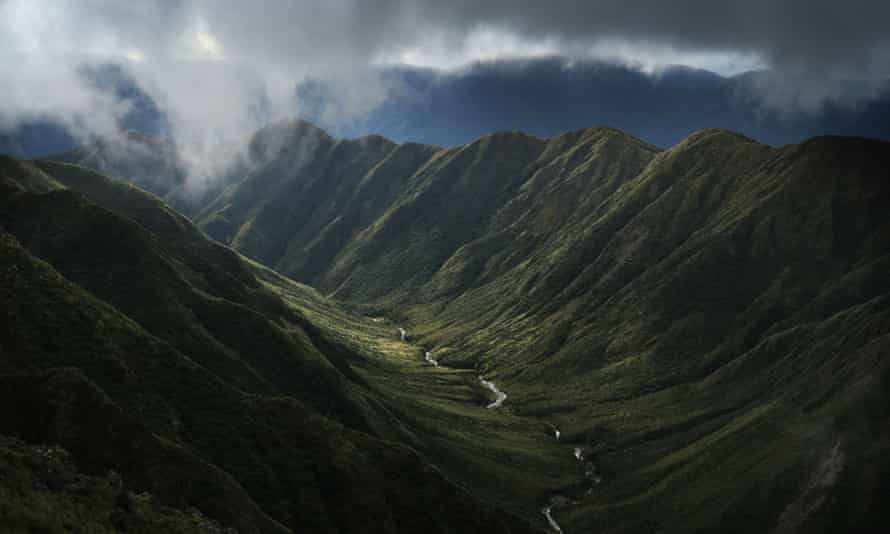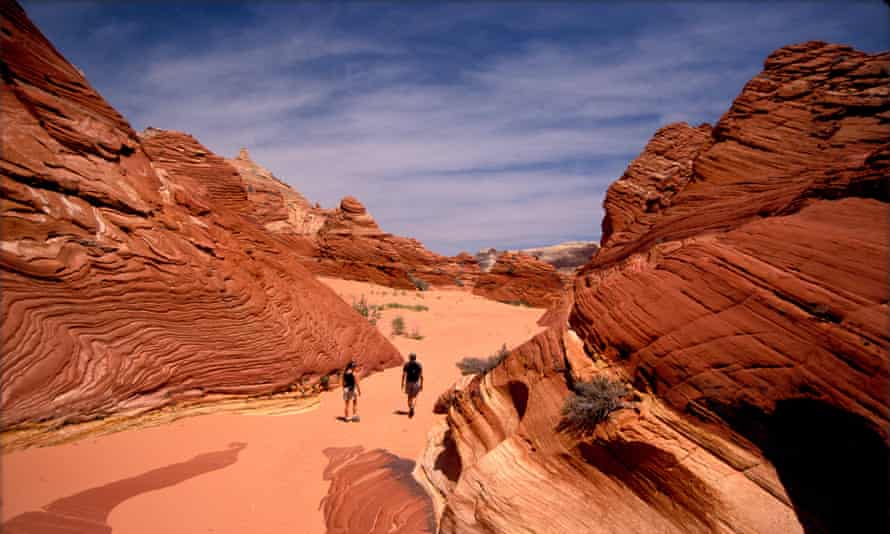What to Do if You Get Lost in the Wilderness and Need Food
T he recent discovery of the body of Geraldine Largay, a 66-year-former backpacker who got lost on the Appalachian Trail in Maine and survived 26 days earlier succumbing to exposure and starvation, marks the beginning of another summer flavor of hikers losing their way and sometimes paying for it with their lives.
Y'all might recollect that with the remarkable popularity of Television receiver survival shows, everyone would already know all they need to know to alive through getting lost. Alas, the eternal quest for college ratings ways these shows foolishly focus on the bizarre, the ridiculous and the idiotic. Why would you spend days amalgam a laughable construction that can't even keep out the pelting? What happened to the regular old raincoat?
I once spent a week with a survivalist for a story. He showed me how to build a bow-and-drill – an aboriginal Native American device – to light a burn down. Really? What's incorrect with a lighter? On another consignment, a survivalist taught me what plants were edible and how to skin a rabbit. C'monday. What hiker doesn't have a handful of energy bars in their backpack?
People who get lost and dice in the wilderness ofttimes take all they need in their backpack to survive. These items are commonly called the "x essentials": knife, matches/lighter, map and compass, headlamp, sunglasses/sunscreen, raincoat, extra clothes, food, h2o (and purification), first aid kit (with whistle).
To this listing, yous tin can besides add new tech essentials: a GPS tracking device, a GPS app for your cellphone, a personal locator buoy or a satellite phone. Most of these crave considerable field time practise before taking them into the wood.
Two years ago, I hiked upwardly the highest mountain in Utah, Kings Peak, and was astonished to find a pack of Male child Scouts scrambling to the elevation. They were in basketball shorts, T-shirts and sneakers. The sentinel master was an overwhelmed Mormon dad who offered that every fourth or 5th child had a pack with water and food. And then much for the scout'south motto: exist prepared.

Not getting lost starts long before getting to the trailhead. You should not only have the x essentials with you, just know how to utilise them.
Being able to "read" contours on a map – what is a mountain, what is a valley; contour lines point upstream crossing creeks and point downhill crossing ridges – and recognize these features in the landscape around you is perhaps the most valuable skill, and not surprisingly, the biggest deficit among novice hikers (I once did an informal survey of hikers in Rocky Mountain national park and establish that less than l% really knew how to use a map and compass).
Earlier heading out, go out a detailed description of where you're going and when you wait to be back with a close friend or relative. This will crave you lot to have a close await at your map and actually have a plan.
Identify landmarks, potential hazards (stream crossings, snowfields) and distances. Leaving a photocopy of the map with your bodily route drawn on it could be invaluable if something untoward happens.
Go ahead and bring your cellphone, fully charged, with emergency contacts already on information technology – merely don't for a minute remember your phone will save you lot if you screw up. Cheque the point atmospheric condition forecast for exactly where y'all're going. If information technology's expected to be raining, snowing or blowing, think twice. Finally, if y'all tin find someone fit and fun, go with a partner.
Get an tall offset. All things being equal, you should be hiking at daybreak. Everything is easier and safer with more than time and more sunlight. Also, in the mountains, afternoon thunderheads are common and dangerous – retrieve lightning and hypothermia. Before leaving the trailhead, hide a spare set of keys somewhere on the vehicle and tell your partner where they are.
On the trail, y'all should exist regularly matching landmarks on the map – peaks, river crossings, signs – with their three-dimensional counterparts in the real world. And keep runway of time. Marking on your map how long information technology takes to climb upward to a saddle or through a ravine. Note conditions and incline. On 1 mini-expedition to New Zealand, I climbed 6 peaks in seven days. On every top I documented how long it took to go how far, vertical gain, aspect, snow conditions, wind and precipitation. These details gave me plenty information to solo the final tiptop, Mt Cook, in four hours.
Take pictures, lots of them. You'll be pleased you did when you get dorsum domicile, and, if you exercise get lost, they provide essential information for finding your way back.

Peer behind you regularly to know what the landscape looks like going the other way. If you're on a faint trail, y'all might leave tiny reminders of your passing, like a small-scale limb in an unlikely place.
If y'all call back you've washed everything right and yous still end upwardly lost, well, welcome to the society. If you lot hike a lot, you'll occasionally get turned around. I've been lost in Tibet and in the Sahel outside Timbuktu, in the Himalayas of Bhutan, and in the mountains not thirty miles from my domicile.
Every putative adept, graphic survival book and lame Television set program will tell you that you should not panic. Yep, correct. Unless you lot get lost and find your manner out frequently, beingness lost will not experience comfortable. Yous might well begin to panic. The flim-flam is to let your panic laissez passer.
There is a useful acronym for what to do when you're lost: STOP.
S is to only stop. Frantically moving faster volition just get y'all more lost. Sit, and breathe from your belly (brusque quick breaths merely increase the symptoms of anxiety – lightheadedness, trembling, confusion). Drink and swallow. With whatever luck, your amygdala (the almond-size flight-or-fight controller in your head) will at-home down and your cerebral cortex (responsible for rational thinking) will take over over again.
T stands for recollect. Ask yourself some basic questions. Which direction were you going? What was the last landmark you lot recognized? How long ago was that? How far have you come since? Hiking on a trail with a pack, virtually people travel only well-nigh two miles per hour. Where was the last time you knew where yous were?
O is for observe. Look effectually y'all: can you see any landmarks? Tin you lot recognize a craggy mountain peak or arcing valley? Try to detect what you see around y'all on the map. Get out your camera, become back through the pictures and do the aforementioned affair. Recollect about fourth dimension. How long have you been hiking? How do y'all feel? How long before dusk? What is the weather doing? What is the weather predicted to practise? Is there natural shelter nearby? Is at that place dry fuel for a fire?
P means plan. Don't motion until yous have a plan. (If and when yous do move, do so methodically and observantly.) If you whistle, might someone hear you? Do y'all have enough daylight to endeavour to retrace your route? Should you consider building a burn considering it is almost night?
And finally – can you make a call? Tin yous text? If yous exercise become through, tin you tell anyone where y'all are?
Geraldine Largay sent multiple text letters, none of which went through. Having a cellphone doesn't, and shouldn't, mean you'll be saved. Y'all should offset endeavor to relieve yourself. Ane of the oft-stated reasons for going into the wilderness is to have the opportunity to exist more than self-reliant. Getting lost is one of those opportunities.
Except in canyon land, walking downhill, especially in forests and mountains, volition often get you out. It won't be easy, and it will involve considerable bushwhacking, simply eventually you'll hit a trail or old logging road. This is especially truthful in the eastern United states, where it is substantially impossible to e'er be more ten miles from a road. (The near remote identify in the lower 48 states, near the s-eastward corner of Yellowstone national park, is still simply 23 miles from a road. When I was there, we saw a dozen wolves, two grizzlies, and no humans.) Even if you're only moving at a crawl, keep going downhill and after, say, 10-xx hours, you'll achieve some form of civilization.

And then let's say your cellphone has no coverage and you don't know how to use a map and compass and you didn't take any pictures and you lot're a little panicky – your average lost person. What to do? Or in the immortal lyrics of the Disharmonism, "should I stay or should I go?" Depends.
If you still have lots of daylight, it is often worth trying to retrace your path. Endeavour to locate your footprints, or rocks that moved when you stepped on them – anything that's a sign of your passing. Leave obvious landmarks (piddling stone cairns, piles of branches) all along your return path. If you exercise manage to get back to the trail and know where yous are, hightail it out and back to your car. Even if information technology means moving in the dark – article of clothing your headlamp. The last thing y'all want is a search and rescue mission to begin – that always puts other lives at hazard.
If you don't hit a trail, and detect yourself even more lost and confused, just start heading downhill.
If it's nearing dark, stay. Beginning, become warm. Put on your extra layers. If you're wearing a cotton T-shirt, you'll be warmer taking it off and having a constructed fleece against your peel. Attempt to find a natural shelter that might afford some protection from current of air and rain. Collect fuel and beginning a small burn down, enough to keep you lot warm simply unlikely to get out of paw. Eat your granola bar. If you don't have any food left, don't worry about it: the human body can go weeks without food. Nutrient is the least of your concerns. Water, on the other paw, is critical: depending on conditions, humans can live merely three to half-dozen days without h2o. But don't go searching for water in the night. Sit there, stay warm, and suffer through the dark.
1 very difficult condition is common cold pelting. A burn down won't be possible and hypothermia is a life-threatening possibility. If this is the case, zip up your raincoat, effort to become inside a cave or a makeshift shelter, and jog steadily in place.
In the morning time, reassess. If you lot recall yous might be able to retrace your steps back to a known location, attempt it, leaving breadcrumbs along the way. If this is not possible, whistle your ass off, hang all your bright apparel on tree limbs, build an SOS of rocks or branches in a clearing, utilize a mirror to bounce the sunlight in multiple directions, move to the top of a loma to get cellphone service.
If yous practise all these things, chances aren't bad that you'll exist found. Merely after several days of waiting, don't permit your energy go so low that you can't make a real endeavor to get out on your own.
Thousands of hikers become lost every year and manage to discover their way out (usually with a dandy story near narrowly escaping disaster). A few navigational skills and the right equipment are useful, merely mutual sense and equanimity are paramount. The truth is, getting lost doesn't kill anybody. You don't die from not knowing where you are – yous dice from bad decisions.
Source: https://www.theguardian.com/travel/2016/may/31/wilderness-survival-outdoor-gear-life-saving-tips-hiking-camping
0 Response to "What to Do if You Get Lost in the Wilderness and Need Food"
Post a Comment